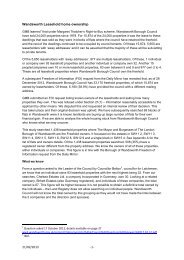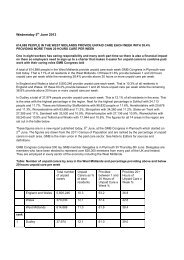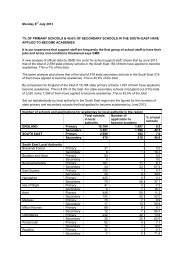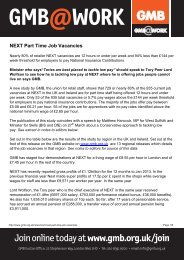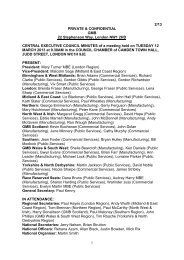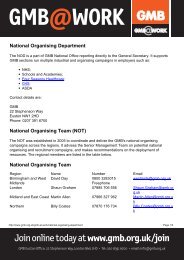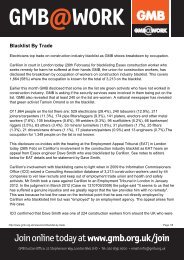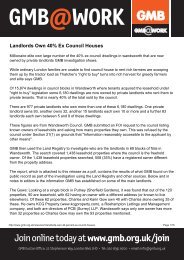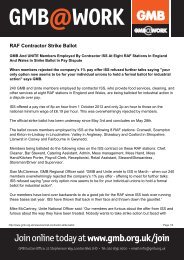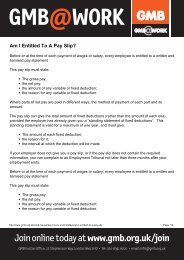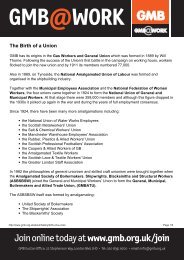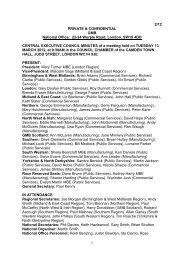WO toolkit 2012 complete.pdf - GMB
WO toolkit 2012 complete.pdf - GMB
WO toolkit 2012 complete.pdf - GMB
Create successful ePaper yourself
Turn your PDF publications into a flip-book with our unique Google optimized e-Paper software.
SECTION 5.26<br />
26. Can I take paid paternity leave?<br />
The right to paid paternity leave was introduced in April 2003.It is the right to be“absent from work<br />
for the purpose of caring for a child or supporting the child’s mother”.<br />
To qualify for paternity leave you must be:<br />
• An employee i.e.someone with a contract of employment.So some casual,temporary or agency<br />
workers may not qualify,and<br />
• The biological father,or<br />
• The husband of the child’s mother,or<br />
• The partner of the child’s mother(this is defined as a person,whether of a different sex or the<br />
same sex,who lives with the mother in an enduring family relationship but is not a blood relative.<br />
You must also:<br />
• Have been continuously employed for 26 weeks by the end of the 15th week before the EWC(if the<br />
baby is born early,but the qualifying condition would otherwise have been met,you still qualify);<br />
• Still be employed by your employer up to the child’s birth;<br />
• Have or expect to have responsibility for the upbringing of the child where you are the biological<br />
father;<br />
• Have or expect to have the main responsibility(apart from the responsibility of the mother of the<br />
child)where you are the mother’s husband or partner but not the father of the child.<br />
You can choose to take either one or two consecutive weeks’paternity leave.You cannot take the leave<br />
at separate times.Leave must be taken within 56 days of the birth.If the baby is born prematurely you<br />
can take leave at anytime from the actual date of birth to up to 56 days after the original EWC.<br />
You can choose whether leave starts from:<br />
• The actual day of the child’s birth/next working day,or<br />
• A day falling a specified number of days after the birth,or<br />
• A pre-set date after the EWC(but within 56 days of it).<br />
You must give your employer notice of your intention to take paternity leave before the end of the15th<br />
week before the baby is due.You must provide the following information:<br />
• The EWC,and<br />
• Whether you want to take one or two weeks leave,and<br />
• The start date of the leave.You can vary this date by giving 28 days notice.<br />
If you qualify,you will be entitled to statutory paternity pay(SPP)of £112.75 a week or 90 per cent of<br />
your normal weekly average pay,whichever is the lower,during your paternity leave.To qualify for SPP<br />
your average weekly earnings must reach the lower earnings limit for national insurance,(£87 a week<br />
currently).The service qualification is the same as for paternity leave.Agency workers,while not<br />
qualifying for leave may qualify for SPP.<br />
To claim paternity pay you must provide your employer with a signed declaration confirming your<br />
entitlement i.e.your relationship to the child or its mother,that you have responsibility for the child’s<br />
upbringing and that you are taking leave to care for the child or its support the mother,The Inland<br />
Revenue produce a model self-certificate Form SC3 which can be used to give notice(web link:<br />
www.inlandrevenue.gov.uk/forms/sc3.<strong>pdf</strong>.)You can use this form to provide notice for leave and pay at<br />
the same time.In that case the latest you can give it to your employer is the end of the 15th week<br />
before the baby is due.



